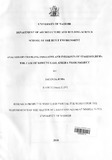| dc.contributor.author | Juma, Jacinta | |
| dc.date.accessioned | 2013-03-22T11:37:12Z | |
| dc.date.issued | 2010 | |
| dc.identifier.citation | Master of urban management | en |
| dc.identifier.uri | http://erepository.uonbi.ac.ke:8080/xmlui/handle/123456789/14957 | |
| dc.description.abstract | One of the key landmarks in the process of slum upgrading in Kenya is the implementation
of the Soweto East pilot project. The project is one of the many projects envisioned in the
Kenya Slum Upgrading Programme (KENSUP). The programme was initiated by the UNHabitat
and the government of Kenya in 2001 with an aim of improving the livelihoods of
people living and working in the slums and informal settlements starting with selected slums
of which the area of study was part. Kibera’s Soweto East village was selected as a pilot
project owing to its high density and physical characteristics. The process of upgrading this
informal settlement has not been without its own challenges including lack of finances, lack
of technical capacity, political interference and conflict due to changing positions and
interests among stakeholders in the project. | en |
| dc.description.sponsorship | University of Nairobi | en |
| dc.language.iso | en | en |
| dc.title | Analysis of changing positions and interests of stakeholders: | en |
| dc.title.alternative | The case of soweto east, kibera pilot project | en |
| dc.type | Thesis | en |

